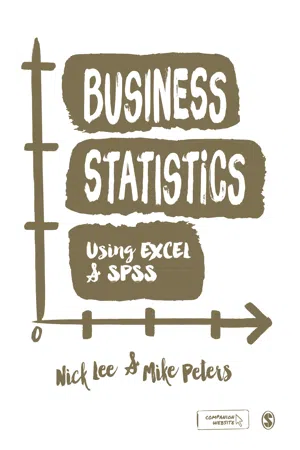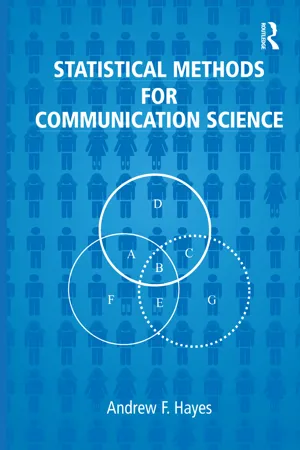Mathematics
Comparing Two Means Hypothesis Testing
Comparing two means hypothesis testing is a statistical method used to determine if there is a significant difference between the means of two independent groups. It involves formulating null and alternative hypotheses, calculating test statistics such as t-test or z-test, and making a decision based on the p-value. This method is commonly used in research and experimental studies to compare the effects of different treatments or interventions.
Written by Perlego with AI-assistance
Related key terms
11 Key excerpts on "Comparing Two Means Hypothesis Testing"
- Richard Harris, Claire Jarvis(Authors)
- 2014(Publication Date)
- Routledge(Publisher)
6 Hypothesis testingChapter overview
In Chapter 5 we emphasised the difference between a sample and the population from which the sample is drawn. We noted that whilst the mean of the sample can be calculated from the data, the mean of the population usually is unknown.In this chapter we introduce hypothesis testing as a way of asking whether the population mean is equal to some hypothesised value.The basic idea is to look at the difference between the sample mean and the hypothetical value. When doing so, we need also to consider the variability of the data. If the population generates highly varied data it could lead to a greater difference between the sample and the true mean than would arise from a more stable population.Finding that the sample mean differs from the hypothesised value is not, in itself, proof that the hypothesised value is wrong. Some difference is inevitable given the variability of the population and the use of sampling to measure it. What we therefore determine is the probability that the difference has arisen by chance. The probability is lower the greater the difference, the less varied the data are, and the more data we have to support our conclusions. If that probability falls below a certain threshold we say the difference is statistically significant.The logic can be extended to testing two or more samples. If their means are very different given the variability of the data and the amount of data we have then it is unlikely they were drawn from the same population. The inference is that the samples are measurements of categorically different things.If there is a difference between samples it could be due to the effect of some intervention – for example, administering a new drug to some patients whilst giving a placebo to others. An effect does not have to be large to be important, but smaller effects are harder to find. Attention must therefore be given to how the research is designed and, in particular, to ensuring sufficient data are collected to enable an effect to be detected. Users of large secondary data sets may need to consider the reverse problem – of having so much data that almost all their results appear statistically significant, even those that have no obvious real-world meaning.- eBook - ePub
Statistics for the Behavioural Sciences
An Introduction
- Riccardo Russo(Author)
- 2004(Publication Date)
- Psychology Press(Publisher)
Chapter 9 Comparing a pair of meansThe matched- and the independent-samples t-testIntroduction
In Chapter 8 we mainly described how to decide if a set of observations was drawn from a given population. We showed how to apply the t-test in assessing the probability that a set of observations, with their observed mean, was drawn from a population with a given mean. In that chapter we also showed how to use sample data to construct confidence intervals that have a given probability of containing the true population mean. In this chapter we will extend the application of the t-test to situations in which we intend to compare the means obtained from two sets of observations. The aim of this comparison is to decide if the two sets are sampled from the same population or not.If the outcome of the t-test gives a sufficiently small probability of the two sets of observations being drawn from the same population, then we declare that the two sets of observations are drawn from different populations (i.e., there is a significant difference between the means). Two different conditions in which the t-test is applied to compare a pair of means will be described:- when the means are obtained from two sets of related observations; and
- when the two sets of observations are independent.
We also explain how to construct confidence intervals for the difference of a pair of population means, and we describe the conditions where the t-test may not be appropriate for comparing pairs of means. This occurs when some of the assumptions underlying the use of the t-test are violated. For these cases we indicate alternative ways to analyse the data. Given the strong similarity to the one-sample t-test, we first describe the application of the t - eBook - ePub
- Andy Field, Jeremy Miles(Authors)
- 2010(Publication Date)
- SAGE Publications Ltd(Publisher)
t-test.9.2. Looking at differences
Rather than looking at relationships between variables, researchers are sometimes interested in looking at differences between groups of people. In particular, in experimental research we often want to manipulate what happens to people so that we can make causal inferences. For example, if we take two groups of people and randomly assign one group a programme of dieting pills and the other group a programme of sugar pills (which they think will help them lose weight) then if the people who take the dieting pills lose more weight than those on the sugar pills we can infer that the diet pills caused the weight loss. This is a powerful research tool because it goes one step beyond merely observing variables and looking for relationships (as in correlation and regression).3 This chapter is the first of many that look at this kind of research scenario, and we start with the simplest scenario: when we have two groups, or, to be more specific, when we want to compare two means. As we have seen (Chapter 1 ), there are two different ways of collecting data: we can either expose different people to different experimental manipulations (between-group or independent design), or take a single group of people and expose them to different experimental manipulations at different points in time (a repeated-measures design).9.3. The t-test
We have seen in previous chapters that the t-test is a very versatile statistic: it can be used to test whether a correlation coefficient is different from 0; it can also be used to test whether a regression coefficient, b, is different from 0. However, it can also be used to test whether two group means are different. It is to this use that we now turn.The simplest form of experiment that can be done is one with only one independent variable that is manipulated in only two ways and only one outcome is measured. More often than not the manipulation of the independent variable involves having an experimental condition and a control group (see Field & Hole, 2003). Some examples of this kind of design are: - eBook - ePub
Medical Statistics
A Guide to SPSS, Data Analysis and Critical Appraisal
- Belinda Barton, Jennifer Peat(Authors)
- 2014(Publication Date)
- BMJ Books(Publisher)
Chapter 3 Comparing two independent samplesDo not put faith in what statistics say until you have carefully considered what they do not say.WILLIAM W. WATTObjectives
The objectives of this chapter are to explain how to:- conduct an independent two-sample, parametric or non-parametric test
- assess for homogeneity of variances
- calculate and interpret effect sizes and 95% confidence intervals
- report the results in a table or a graph
- understand sample size requirements
- critically appraise the analysis of data from two independent groups in the literature
3.1 Comparing the means of two independent samples
A two-sample t-test is a parametric test used to estimate whether the mean value of a normally distributed outcome variable is significantly different between two groups of participants. This test is also known as a Student's t-test or an independent samples t-test. Two-sample t-tests are classically used when the outcome is a continuous variable and when the explanatory variable is binary. For example, this test would be used to assess whether mean height is significantly different between a group of males and a group of females.A two-sample t-test is used to assess whether two mean values are similar enough to have come from the same population or whether their difference is large enough for the two groups to have come from different populations. Rejecting the null hypothesis of a two-sample t - eBook - ePub
- Nick Lee, Mike Peters(Authors)
- 2015(Publication Date)
- SAGE Publications Ltd(Publisher)
true experiment would be one where the researcher controlled the groups in some way. Take for example a classic medical research design. Perhaps a pharmaceutical company is interested in determining whether its latest potential blockbuster drug really does work to reduce headaches. We might randomly split 100 people into two groups. One group of 50 gets to take the new drug, and one group of people takes what is called a placebo (which is exactly the same in appearance, but should have no effect – normally a starch or sugar pill). Later we measure the incidence of headaches in some way. This is a classic experimental design.In both cases, we have two groups, and we want to compare them in some way. Figure 12.1 shows this diagrammatically. There are many ways we could compare the two groups, and we will begin by exploring the most common – comparing the difference between the mean value of some variable of interest.Figure 12.1 Basic Experiment ExampleInferences about Differences in Population Means Where the Population Standard Deviations Are Known
So, whenever we have two groups – such as for example in the experimental designs above – we may be interested in comparing them. In order to set you up for what follows, let’s get some terminology straight first. First and foremost, it is important to understand that here (unless we tell you specifically otherwise) you should think about it as if you are testing samples from two separate populations. These two samples are independent, and an element can only be a member of one of the samples (there is no overlap in the populations).Moving on, let μ1 denote the mean of population 1 and μ2 denote the mean of population 2. What we are doing is using our sample data to make some inference about the difference between those two means, which we denote by the simple operation μ1 − μ2 . To make inferences about the population mean difference, we need the aforementioned independent samples. As such, we need to take a simple random sample n1 from the first population and another simple random sample n2 - eBook - ePub
Social and Behavioral Statistics
A User-Friendly Approach
- Steven P. Schacht(Author)
- 2018(Publication Date)
- Routledge(Publisher)
9Hypothesis Testing Between Two Sets of Observations
Having explored in the last chapter how confidence intervals are constructed and what they represent, we can take these ideas one step further and show how they are also used to test hypotheses. (Recall from Chapter 1 that estimating population parameters and hypothesis testing are the two things that inferential statistics enable us to do.) While the construction of confidence intervals is important to social scientists who undertake quantitative research, perhaps an even more important function is that they enable us to test hypotheses. Quite simply, hypothesis testing is what almost all quantitative studies and journals ultimately report; these are the all-important findings. It is through the process of hypothesis testing that the phrase “statistically significant” is derived.Specifically, this chapter first explores the underlying assumptions of hypothesis testing and statistical significance. These ideas are then applied to four types of statistical tests (ways to hypothesis testing); a Z test, a dependent-sample t-test , an independent-sample t-test , and a matched t-test. Because the remainder of this text is largely devoted to hypothesis testing, these four initial tests are viewed as starting points for understanding statistical testing.Hypothesis Testing
All scientists are ultimately interested in explaining how and why certain things occur the way they do. For social scientists, this interest is obviously in terms explaining social phenomena. Social phenomena are a nearly inexhaustible array of every imaginable attitude, behavior, and social characteristic. What social scientists attempt to do is establish relationships of association (two variables tend to occur together) and causality (one variable is seen as bringing about a change in another variable) between different social phenomena.Another way of viewing social phenomena is in terms of a measurable variable. For example, a measurable attitude is whether one supports the legalization of marijuana, a measurable behavior is if one smokes marijuana, and a measurable social characteristic is one’s age. One possible relationship among these three variables might be that those who support marijuana legalization are more likely to smoke it than those who don’t support legalization. Moreover, we might expect that younger people are more likely to support marijuana legalization and to smoke it than older people. If this in fact was found to be true, we would conclude that age and marijuana use are both determinants—seen as causes—of attitudes about legalization. - No longer available |Learn more
- Hugh Coolican(Author)
- 2018(Publication Date)
- Routledge(Publisher)
Chapter 17 Testing for differences between two samplesThis chapter introduces statistical tests for assessing the significance of differences between two samples and also introduces calculations of effect size and power.- The related t test is used where data are in pairs, from repeated measures or matched pairs design. H0 is that the mean of the population of difference means (means of differences between each pair of values in a sample) is zero.
- The t test for unrelated data (from independent samples) tests H0 that the population of differences between two means has a mean of zero; that is, it assumes that the two populations from which the two samples are drawn have identical means.
- The single sample t test is used to test the null hypothesis that a single sample was drawn from a population with a certain mean; we usually wish to show that the sample mean would rarely be drawn from such a population and therefore that the sample is probably drawn from a population with a different mean.
- t tests are a type of parametric or distribution dependent test that depend on certain data assumptions for their results to be valid – homogeneity of variance, interval-level data and a normally shaped sampling distribution. Ways to reduce skew are outlined, including transformation of data.
- These tests are considered robust and more power efficient than their non-parametric equivalents, which are also dealt with here – the Mann-Whitney U for unrelated data and the Wilcoxon Matched Pairs (T) for related data. These non-parametric tests
- eBook - ePub
Business Statistics Using Excel
A Complete Course in Data Analytics
- R. Panneerselvam(Author)
- 2023(Publication Date)
- Routledge India(Publisher)
The alternate hypothesis (H 1 : X ¯ ≤ > k) is opposite the null hypothesis, say, the sample mean is more than the specified constant. In data analysis, three types of hypothesis testing (≤, ≥, and =) will be carried out. In reality, based on the mean(s) and variance(s) of the sample(s) collected from the population, the investigator has to take a decision to accept or reject the null hypothesis. In this process, a significance level (α) is assumed. The decision on whether to accept or reject the null hypothesis may be based on the following. The value of the statistic computed will be compared with the critical value of the statistic for a given significance level for taking the decision. If the computed value of the statistic is more than the corresponding table value, reject the null hypothesis; otherwise, accept the null hypothesis. The value of the computed p (less than 1) will be compared with a given significance level for taking the decision. If the p value is less than the significance level (α), reject the null hypothesis; otherwise, accept the null hypothesis. Further, hypothesis testing is classified into hypothesis testing for the mean of a single sample and hypothesis testing for the difference between the means of two samples [ 1 ]. 10.2 Tests Concerning Single Mean When Mean and Variance of the Populations Are Known and the Size of the Population Is Finite Using the Norm.S.Dist Function Let X be a random variable, which follows a normal distribution, representing an independent population μ and σ 2 be the mean and variance of the population, and these are known for the population parameters n be the size of the population, which is - Melody S. Goodman(Author)
- 2017(Publication Date)
- Routledge(Publisher)
8 Two-Sample Hypothesis TestingThis chapter will focus on two-sample hypothesis testing and will include the following topics:- Dependent samples (paired tests)
- Independent samples
- Sample size and power for two-sample test of means
Terms- cross-sectional study
- independent data
- longitudinal (follow-up) study
- paired (dependent) data
IntroductionIn Chapter 7 , we discussed one-sample hypothesis testing, where we generate a hypothesis about a single distribution. A two-sample hypothesis testing problem allows the comparison of the underlying parameters of two different populations, neither of whose values is assumed known. Two-sample tests are appropriate in many common study designs, including longitudinal and cross-sectional studies.Longitudinal (Follow-Up) Study: A study in which the same group of people is followed over time.Paired (Dependent) Samples: Term used to describe two samples where each data point of the first sample has a corresponding unique data point in the second sample. In this case, there are two measurements taken on the same sample.Let’s say that we are interested in comparing an individual’s body weight before and after an exercise intervention. The subject’s body weight is measured initially (Sample 1) and then again after a set number of weeks (Sample 2). In order to test whether there is a difference in weight due to the intervention, we must use a test that takes into account the dependent nature of the data. The observations (body weights) from the second sample are not independent from the observations from the first sample since they are measured in the same individual. This is a case of paired, or dependent, samples.Cross-Sectional Study:- eBook - ePub
- Bruce J. Chalmer(Author)
- 2020(Publication Date)
- CRC Press(Publisher)
interpretation that differs.Differences in central tendency versus differences in variability
Most studies are concerned with detecting differences in central tendency among groups, and the methods we discuss in this chapter will largely be concerned with that problem. That is, we consider methods for testing hypotheses about whether certain populations differ in terms of some variable on the average.But as we have discussed, central tendency does not tell the whole story. Some studies are more concerned with detecting differences in variability among groups. For example, suppose that we are comparing the sizes of parts produced by two manufacturing processes, one of which is substantially less costly. Even if the cheaper process produces parts that have the same average size, it is quite possible that the size could be more variable than that of the parts produced by the more expensive process. This would be of concern to the people responsible for quality control.Another reason we may be concerned with comparing variability among groups is somewhat less direct. It turns out that some of the methods for comparing group means require the assumption that the populations being compared have equal standard deviations. Thus to use those methods we need to have some way of testing whether the assumption of equal group variability is tenable.9.2 For two paired samples, the problem reduces to the one-sample case.
Paired versus independent samples
Suppose that you wish to study whether college students gain weight, on the average, during their first year on campus. (This phenomenon is known to believers as “the freshman ten”—pounds, that is.) There are two ways in which you might gather sample data to address this question. - eBook - ePub
- Andrew F. Hayes(Author)
- 2020(Publication Date)
- Routledge(Publisher)
In studies with such outcome measures, research questions and hypotheses are sometimes framed as differences in proportions. For example, are men more willing than women to be interviewed by a reporter? Suppose you had a reporter approach people and see if they agreed to be interviewed for a local TV news broadcast. If men and women are equally willing to be interviewed, this implies that in a sample of men and women, the proportion of men agreeing to be interviewed should be the same as the proportion of women who agree. The analysis of categorical outcomes such as this requires different procedures than those discussed in this chapter. Although the comparison of proportions certainly seems like it belongs in this chapter, I instead place a discussion of these methods in Chapter 11, where I describe the problem in terms of association and statistical independence. 10.6 Summary In this chapter, I introduced several common methods for comparing two groups. By far the most popular of these tests is the independent groups t test, used to compare two independent population means based on estimates of these means from a sample. There are several strategies for comparing two groups means, and I argue here that although the pooled variance approach is most commonly used, the Welch-Satterthwaite approach is superior in terms of keeping Type I rates at acceptable levels across the largest variety of situations. Although the pooled variance approach assumes equality of variance, there seems to be little benefit to conditioning the choice of these two tests on the outcome of a variance equality test, as the Welch-Satterthwaite test works quite well even when the population variances are not the same. I also introduced the randomization test for comparing means in an experiment, a test that does not presume random sampling from a population
Index pages curate the most relevant extracts from our library of academic textbooks. They’ve been created using an in-house natural language model (NLM), each adding context and meaning to key research topics.










